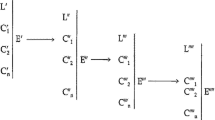Abstract
Using as case studies two early diagrams that represent mechanisms of the cell division cycle, we aim to extend prior philosophical analyses of the roles of diagrams in scientific reasoning, and specifically their role in biological reasoning. The diagrams we discuss are, in practice, integral and indispensible elements of reasoning from experimental data about the cell division cycle to mathematical models of the cycle’s molecular mechanisms. In accordance with prior analyses, the diagrams provide functional explanations of the cell cycle and facilitate the construction of mathematical models of the cell cycle. But, extending beyond those analyses, we show how diagrams facilitate the construction of mathematical models, and we argue that the diagrams permit nomological explanations of the cell cycle. We further argue that what makes diagrams integral and indispensible for explanation and model construction is their nature as locality aids: they group together information that is to be used together in a way that sentential representations do not.




Similar content being viewed by others
Notes
Mechanistic explanations "account for the behavior of a system in terms of the functions performed by its parts and the interactions between these parts" by identifying the "parts and their organization, showing how the behavior of the machine is a consequence of the parts and their organization" (Bechtel and Richardson 2010: 17). Functional explanations involve "analyzing a disposition d of a [system] a into a number of other dispositions d1 … dn, had by a or components of a such that programmed manifestations of the di results in or amounts to a manifestation of d," where a programmed manifestation is one that "could be specified in a program or a flow chart" (Cummins 1975: 759). Piccinini and Craver (forthcoming) maintain that functional explanations are incomplete mechanistic explanations by virtue of omitting structural aspects regarding the location, shape, orientation, and organization of a system's components; Bechtel and Richardson, that elements of mechanistic explanations include elements of functional ones (2010: 89–90).
These models are, in turn, the basis for formulating and testing hypotheses about the biological mechanisms that regulate the cell cycle. The diagrams also can be used to summarize published data. Through peer review, these summaries can be considered to be firmly established. However, in most cases the models involve uncertainty, so that the diagrams can be considered to be encodings of hypotheses. In such cases, the mathematical models also encode hypotheses, and computational simulation experiments with the model can be brought into agreement (or disagreement) with experimental data in order to validate the hypotheses through the diagram, in combination with mathematical modeling and computational simulation. Further discussing these issues would take us beyond the scope of this paper.
But see our previous footnote.
References
Bechtel W, Abrahamsen A (2005) Explanation: a mechanistic alternative. Stud History Philos Biol Biomed Sci 36:421–441
Bechtel W, Richardson RC (2010) Discovering complexity: decomposition and localization as strategies in scientific research. The MIT Press, Cambridge, MA
Brown JR (1997) Proofs and pictures. Br J Philos Sci 48:161–180
Crampin EJ, Schnell S, McCharry PE (2004) Mathematical and computational techniques to deduce complex biochemical reaction mechanisms. Prog Biophys Mol Biol 86:77–112
Cummins R (1975) Functional analysis. J Philos 72:741–765
Goldbeter A (1991) A minimal cascade model for the mitotic oscillator involving cyclin and Cdc2 kinase. Proc Natl Acad Sci 88:9107–9111
Goodwin W (2010) How do structural formulas embody the theory of organic chemistry? Br J Philos Sci 61:621–633
Heinrich R, Schuster S (1996) The regulation of cellular systems. Chapman & Hall, New York
Hempel CG (1965) Aspects of scientific explanation and other essays in the philosophy of science. Free Press, New York
Kell DB, Knowles J (2010) The role of modelling in systems biology. In: Szallasi Z, Stelling J, Periwal V (eds) System modeling in cellular biology: from concepts to nuts and bolts. MIT Press, Cambridge, MA, pp 3–18
Koedinger KR (1992) Emergent properties and structural constraints: advantages of diagrammatic representations for reasoning and learning. AAAI technical report SS-92-02, pp 151–156
Le Novère N, Hucka M, Mi H, Moodie S, Schreiber F, Sorokin A, Demir E, Wegner K, Aladjem MI, Wimalaratne SM, Bergman FT, Gauges R, Ghazal P, Kawaji H, Li L, Matsuoka Y, Villéger A, Boyd SE, Calzone L, Courtot M, Dogrusoz U, Freeman TC, Funahashi A, Ghosh S, Jouraku A, Kim S, Kolpakov F, Luna A, Sahle S, Schmidt E, Watterson S, Wu G, Goryanin I, Kell DB, Sander C, Sauro H, Snoep JL, Kohn K, Kitano H (2009) The systems biology graphical notation. Nat Biotechnol 27:735–741
Millat T, Bullinger E, Rohwer J, Wolkenhauer O (2007) Approximations and their consequences for dynamic modeling of signal transduction pathways. Math Biosci 207:40–57
Nurse P (1990) Universal control mechanism regulating onset of M-phase. Nature 344:503–508
Nurse P (2000) A long twentieth century of the cell cycle and beyond. Cell 100:71–78
Perini L (2005a) Explanation in two dimensions: diagrams and biological explanation. Biol Philos 20:257–269
Perini L (2005b) The truth in pictures. Philos Sci 72:262–285
Piccinini G, Craver C (forthcoming) Integrating psychology and neuroscience: functional analyses as mechanism sketches. Synthese. doi:10.1007/s11229-011-9898-4
Saraiya P, North C, Duca K (2005) Visualizing biological pathways: requirements analysis, systems evaluation and research agenda. Inform Vis 4:1–15
Schafer KA (1998) The cell cycle: a review. Vet Pathol 35:461–478
Sible JC, Tyson JJ (2007) Mathematical modeling as a tool for investigating cell cycle control networks. Methods 41:238–247
Tyson JJ (1991) Modeling the cell division cycle: Cdc2 and cyclin interactions. Proc Natl Acad Sci 88:7328–7332
Acknowledgments
We thank Laura Perini, Thomas Millat, Anuradha Chauhan, and Justin Barnard for helpful comments on earlier versions of this paper.
Author information
Authors and Affiliations
Corresponding author
Rights and permissions
About this article
Cite this article
Jones, N., Wolkenhauer, O. Diagrams as locality aids for explanation and model construction in cell biology. Biol Philos 27, 705–721 (2012). https://doi.org/10.1007/s10539-012-9311-9
Received:
Accepted:
Published:
Issue Date:
DOI: https://doi.org/10.1007/s10539-012-9311-9




